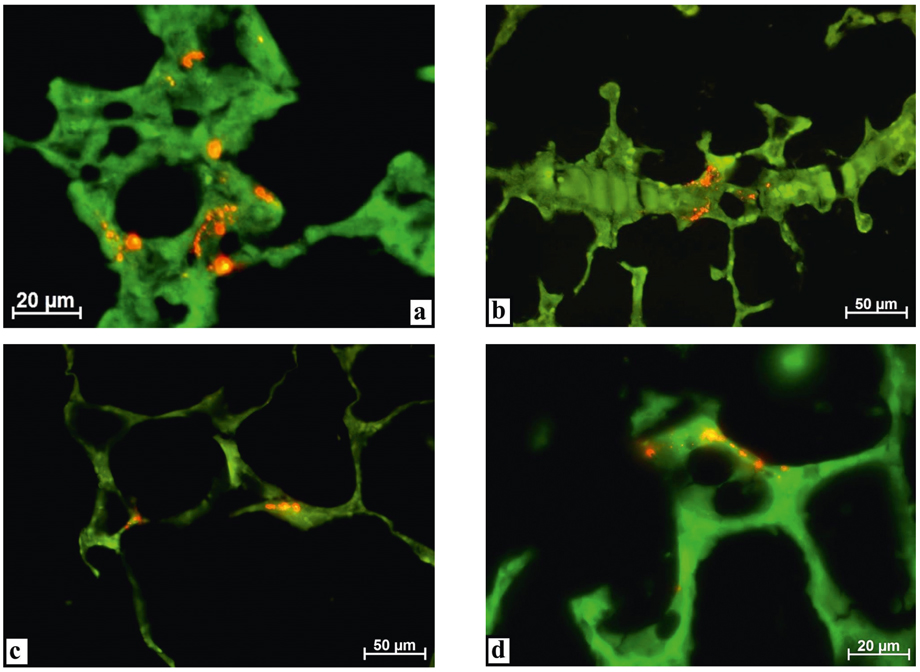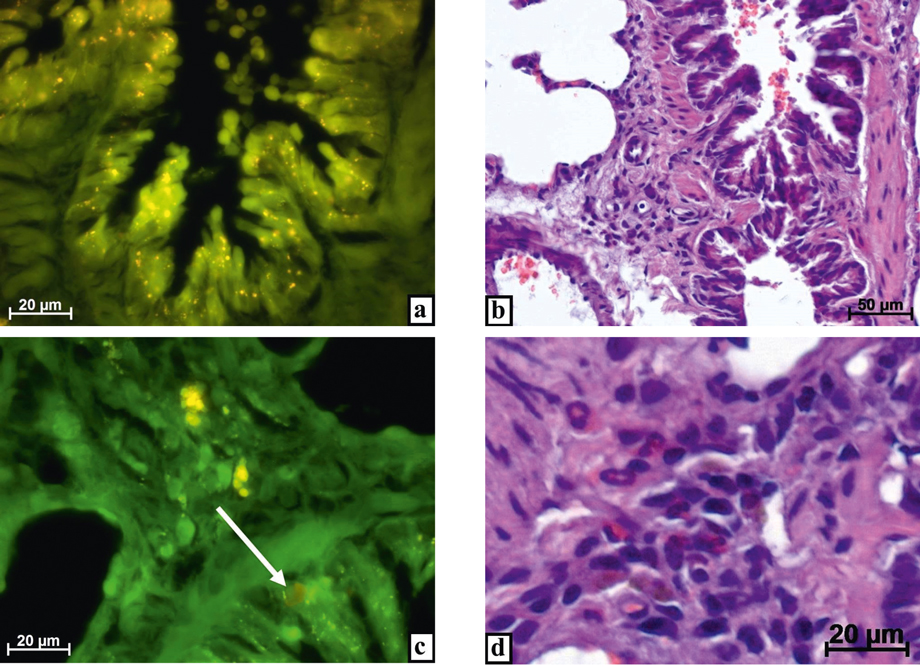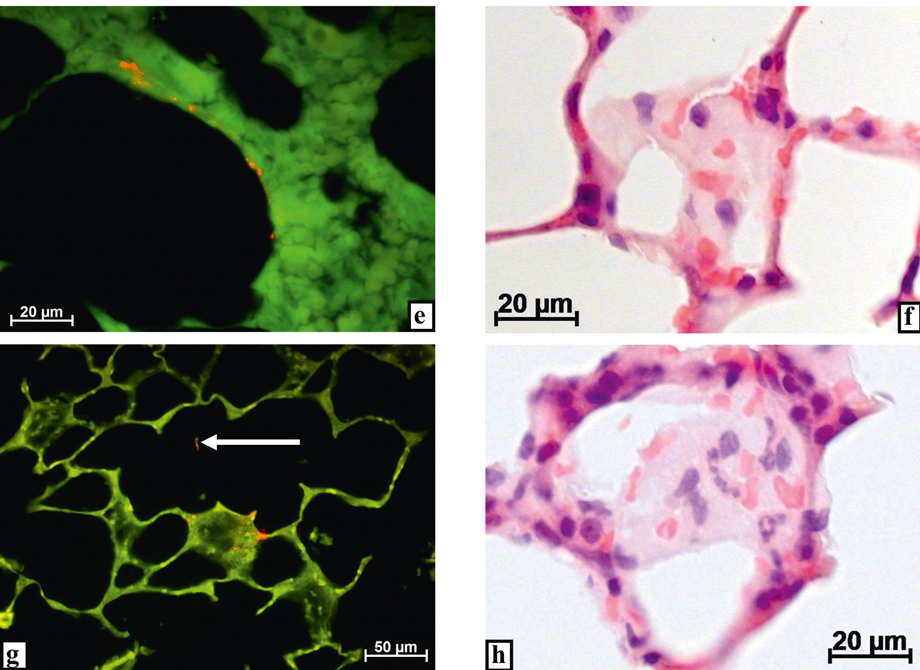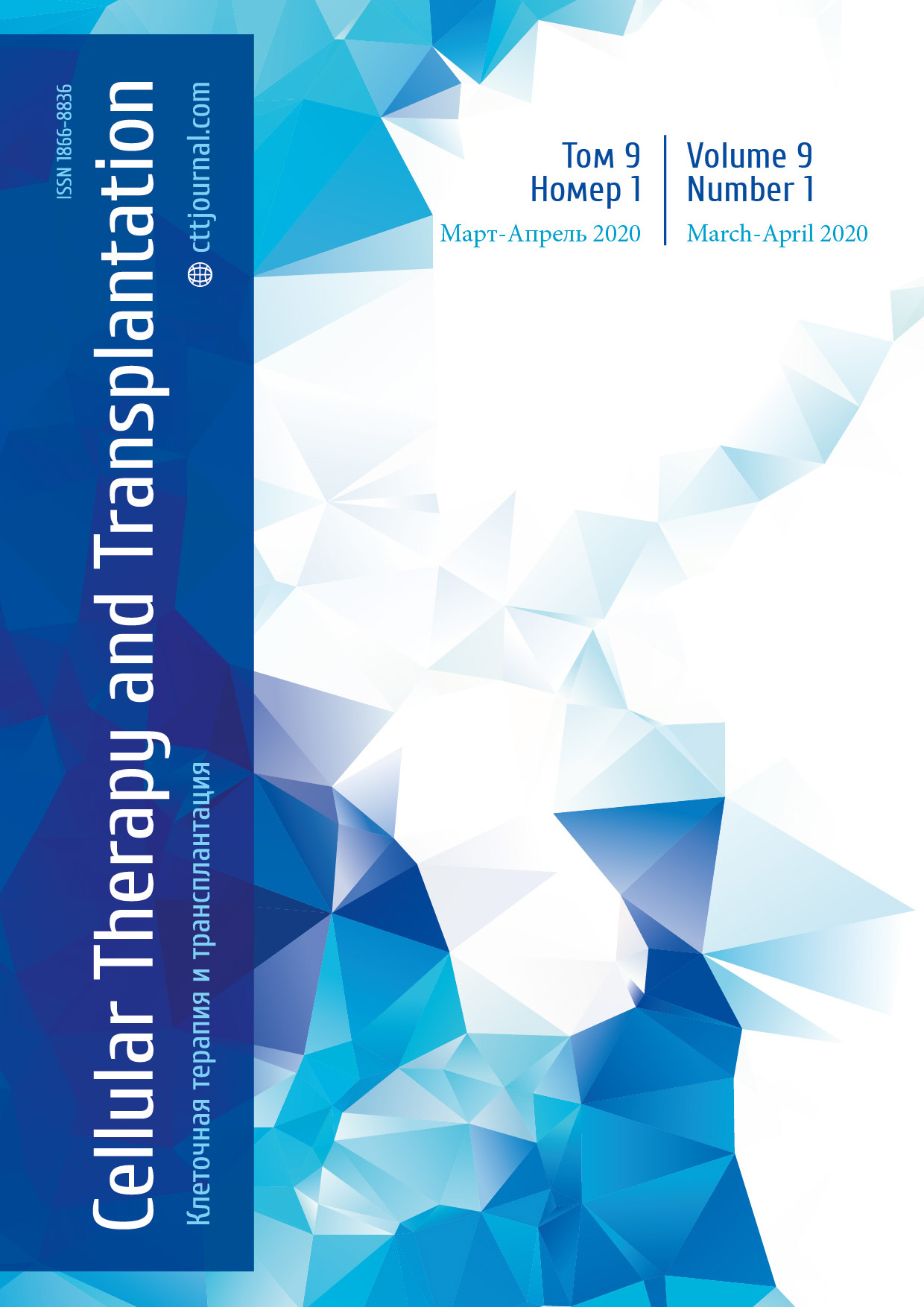Opportunity for elimination of injected multipotent stromal cells via lungs
Igor V. Maiborodin1, Roman V. Maslov1, Tatiana V. Mikheeva1, Sergey V. Marchukov1, Vitalina I. Maiborodina2, Aleksandr A. Shevela1
1 Institute of Chemical Biology and Fundamental Medicine, Russian Academy of Sciences, Siberian Branch, Novosibirsk, Russia
2 Institute of Molecular Pathology and Pathomorphology, Federal Research Center of Fundamental and Translational Medicine, Novosibirsk, Russia
Correspondence
Professor Igor V. Maiborodin, Chief Research Associate, Laboratory of Health Management Technologies, The Center of New Medical Technologies, Institute of Chemical Biology and Fundamental Medicine, The Russian Academy of Sciences, Siberian Branch, Akad. Lavrenteva St. 8, Novosibirsk, 630090, Russia
Phone: +7 (913) 753 0767
Е-mail: imai@mail.ru
Accepted 21 February 2020
Summary
In compliance with most observations, the multipotent stromal cells (MSC) remain at the site of implantation after local application, whereas intravenously administrated MSC first appear in lungs followed by distribution to different tissues and organs, however, at much smaller quantities. Moreover, there are data on predominant migration of systemically infused MSC into liver, and not into the lungs. Destruction and elimination of introduced MSC, according to published data, occurs in the spleen, kidneys and liver. Due to controversial results on MSC distribution and elimination from the body, the aims of our study were as follows: to investigate the fate of tissue-injected autologous bone marrow-derived multipotent mesenchymal stromal cells (MMSC) entering liver, kidneys and lungs, as well as to obtain new evidence for their elimination from the body via these organs.
Materials and methods
The work is based on morphological evaluation of lungs, liver and kidneys from 6-mo old male rats (Wag inbred strain) at different terms after subcutaneous injection of MMSC labeled with membrane-binding Vybrant® CM-Dil dye. Morphological patterns and distribution of labeled objects in these organs were investigated using visible and luminescent microscopy.
Results
The first luminescent macrophages observed with rhodamine colour-filter were initially revealed in the lungs one week after MMSC injections. The number of luminescent cells and intensity of their fluorescence increased gradually over successive 2-4 weeks. By 2-3 weeks, this red tint was revealed in the inclusions of epithelial cells in some bronchioles. The Vybrant® CM-Dil-labeled objects were sometimes detected at the very edge of alveoli, and even partially located in alveolar lumen. The objects stained by Vybrant® CM-Dil were not found in liver and kidneys at any observation terms.
Conclusion>/h3>
Following subcutaneous injection, MMSCs and their fragments seem to enter bloodstream and migrate to the lungs, where these cells are phagocytized by macrophages. Only after filtration in lungs, the MMSC debris can further disseminate throughout the body. Elimination of detritus from injected MMSC is possible in lung alveoli and further, via bronchial system, to the ambient. Vybrant® CM-Dil-labeled MMSC fragments were not found in liver and kidneys, thus disagreeing the literature data on potential role of these organs in the destruction or removal of injected autologous or foreign MSC.
Keywords
Multipotent stromal cells, elimination, lungs, macrophages, alveoli, liver, kidneys.
Introduction
The increasing implementation of cellular therapies into clinical practice and development of personalized medicine requires appropriate studies of differentiation, organ distribution, destruction and elimination of widely used multipotent stromal cells (MSC). According to the work of most researchers, the MSCs remain at the site of implantation after local administration, whereas intravenously infused MSCs first appear in lungs, being later on distributed to different tissues and organs [1, 2], however, at much fewer quantities. Moreover, there are reports on predominant migration of systemically administrated MSC into liver, and not into the lungs [3, 4].
The final fate of exogenously introduced MSC is still unclear. There are reports that MSCs are absorbed by immunocompetent cells of the recipient [5, 6], there is evidence of the production of antibodies against transplanted MSC with their rejection [7], the recipient can acquire immunity to MSC after repeated administration via increase in the percentage of T-cells [8]. Another possible way of eliminate MSC is that they can undergo apoptosis and disintegrate. The results of studies by A. Galleu et al. [9] are very interesting, they showed that apoptosis of MSC immediately after administration may be necessary for therapeutic efficacy. The destruction and elimination of introduced MSC, according to published data, occurs in the spleen [10], kidneys [10-12] and liver [10, 11]: the organs responsible for the destruction of other cells. However, Y. Takasaki et al. [4] found very few injected MSC in kidneys, and Y. Lei et al. [3] generally reject the possibility entering of such cells in the kidneys.
Due to the controversial data from literature about distribution and disappearance of MSC from the body, the aims of our study were as follows: to investigate final fate of tissue-injected autologous bone marrow-derived multipotent mesenchymal stromal cells (MMSC) entering liver, kidneys and lungs, as well as to obtain new evidence for their elimination from the body via these organs.
Materials and methods
The experimental study was designed to perform morphological examination of lungs, liver and kidneys from male rats (Wag inbred strain) at 6 months of age (body mass 180-200 g).
It was performed at different terms after subcutaneous MMSC injections as made during cosmetic procedures. All manipulations with animals were carried out in aseptic operating room, in compliance with the "Rules for the Works Using Experimental Animals".
Isolation, characterization, preparation and introduction of MMSC in the experiment
MMSC were isolated from the bone marrow of syngeneic rats, characterized and cultured in accordance with our previous works [5, 6]. The second-passage MMSC were membrane-stained by Vybrant® CM-Dil solution (Thermo Fisher Scientific, USA), with maximal absorption wavelength of 553 nm, emission at 570 nm [5, 6]. The dye was added to MMSC suspension (5 µL per 106 cells in 1 mL serum-free culture medium), then gently and thoroughly mixed by pipetting, and left for 20 min in a CO2 incubator at 37°C, under 100% humidity. Then, MMSC were centrifuged for 5 min at 1500 rpm, the medium with the dye was discarded, and MMSC were resuspended in a new aliquote of warm medium. After 3-fold washing, MMSC were resuspended in warm medium and brought to a concentration of 106 cells/mL. Thereafter, following skin disinfection with ethyl alcohol, 100 μL of MMSC suspension in culture medium (1 mL contained 1x106 cells with a viability of >92%) was injected subcutaneously by insulin syringe into the region of upper third of the femur/inguinal ligament. The animals were sacrificed at 1; 2; 3; 4; and 5 weeks after MMSC injection. Intact rats were used as a control. In each group, 12 animals were used at any experimental point.
Sample processing for morphology studies
For morphological evaluation, the fragments of lungs, liver, and kidneys were isolated. The objects were fixed in a 4% paraformaldehyde in phosphate buffer solution (pH 7.4) for at least 24 hours, then dehydrated in a series of increasing ethanol concentrations. The samples were cleared with xylene, and embedded into Histoplast. The sections with a thickness of 5-7 μm were stained by hematoxylin and eosin, and examined with Axioimager M1 light microscope (Zeiss, Germany) at a magnification of ≤1200x.
In addition, unstained sections were examined in the luminescence mode of Axioimager M1 microscope using colour filters for Alexa Fluor 488 (excitation range 450-490 nm, registration range 515-∞ nm) and for Rhodamine (Rhod – excitation range 540-552 nm, registration range 575-640 nm). Tissue examination under UV light with Alexa Fluor 488 filter was aimed for detecting green background autofluorescence, which, firstly, provides good contrast for other luminescent objects, e.g., with Rhodamine filter (red color and its shades are clearly visible on a green background). Secondly, it is possible to see the structure of the studied tissues and better localize the objects with red luminescence in a distinct organ [5, 6].
Automatic exposure was used for obtaining microphotographs, when combining the images using Alexa Fluor 488 and rhodamine filters. Thus, one may obtain green and red (or orange and yellow) color, depending on prevalence of the glow intensity using distinct filters. Brighter fluorescence when using an Alexa Fluor 488 filter gives green luminescence, using a rhodamine filter produced red color. Yellow luminescence and its shades resulted from mixing green and red colors at different ratios [5, 6].
Results and discussion
The first luminescent objects of various shape and size, when applying rhodamine filter, were revealed in lungs by one week after MMSC injection (Fig. 1a). Numbers and fluorescence intensity of such luminous particles gradually increased over the observation period of 2-4 weeks (Fig. 1b, c, d). Only at 5th week, the number of luminescent structures decreased slightly, but remained detectable in significant number of cells. Most likely, the large fluorescent objects should represent macrophages, and smaller luminescent inclusions are their lysosomes. This conclusion was made on the basis of the following visual data [5, 6]: (1) Cell size: only few cells can exceed 20 µm in diameter, and macrophages are among such large cells; (2) Presence of many oval, clearly limited, fluorescent inclusions of different-size, which, most likely, are lysosomes. It should be noted that MMSC cytoplasm is rather evenly stained by Vybrant® CM-Dil [13]; (3) Irregular cell shape.

Figure 1. Rat lungs at different terms after inguinal subcutaneous MMSC injection. The combined images were obtained in luminescent mode of the microscope using Alexa 488 and rhodamine colour-filters
A, Numerous objects with predominant fluorescence obtained with Rhodamine filter are contained within alveolar wall one week after the MMSC injection.
B, Paravasal arrangement of structures with predominantly glowing inclusions with Rhodamine filter at 2 weeks after MMSC administration.
C, The objects with predominant fluorescence revealed with Rhodamine filter are observed in the wall of alveoli at 3 weeks after MMSC injection.
D, Four weeks after MMSC application: the particles with more intense fluoresce seen with Rhodamine filter are located in the alveolar wall.
Most likely, the Vybrant® CM-Dil-labeled MMSCs seem to penetrate into the bloodstream with time [6], migrate to the heart and arrive to lung, where are captured by numerous perivascular and alveolar macrophages, as it happens in other tissues [6]. Due to phagocytized material, the macrophage lysosomes become luminescent when exposed to UV light. When using Rhodamine colour filter [5, 6], one cannot also exclude staining of macrophage membranes by Vybrant® CM-Dil.
Due to short lifetime of injected MMSC in the tissues, an opportunity exists for migration of both cells and their fragments (debris) through blood flow into pulmonary circulation [5, 14, 15]. This MMSC debris is adsorbed by pulmonary macrophages causing staining of their structures. There is an opportunity of macrophage migration with other antigens, including those with Vybrant® CM-Dil-stained detritus, from the tissues via blood to the lungs. In any case, the lung tissues and structures do not contain any intact Vybrant® CM-Dil-labeled MMSC, but only their fragments, or debris-containing macrophages.
Hence, the described time-dependent dynamics of luminescent cell numbers in the lungs could be well explained by gradual replacement of injected MMSCs and relevant structures by cell populations differentiating from the own recipient cells. According to the literature data, this process is maximally expressed in rats within 2-3 weeks after the MMSC administration, when labeled cells disappear from the tissues, and the number of luminescent macrophages in regional lymph nodes becomes the largest [5].
Thus, one may suggest that, the detritus from injected MMSCs site early arrives to lungs, i.e., the cell fragments which were initially non-viable or died in situ soon after administration, due to drastic changes in their viability [5, 14, 15]. Then, starting from 2 weeks, when there is a massive elimination of labeled cells from tissues [5], the content of the dye-labeled objects in the lungs increases sharply, when using a Rhodamine colour-filter. It could be suggested that the stained MMSCs or their detritus do not enter lungs at later terms, and only macrophages that have previously absorbed a large volume of labeled objects will show fluorescence. Consequently, the luminescence intensity and the number of fluorescent cells will gradually decrease, due to the migration of such macrophages, their destruction and, possibly, due to the gradual lysis of stained structures, with a decrease in the Vybrant® CM-Dil concentration.
It should be especially noted that after 2 weeks, upon careful examination of the lungs, a red tint was found in the inclusions in the epithelial cells of some bronchioles (Fig. 2a), which contained a certain amount of cellular detritus, these was clearly visible when staining sections by hematoxylin and eosin (Fig. 2b). At week 3, the inclusions in epithelial cells of individual bronchioles showed a more distinct red staining when exposed to UV light via a Rhodamine filter. A careful study sometimes showed oval objects with weak red fluorescence, similar to cells with destruction phenomena: the empty cell membranes after loss of its content, organelles (Fig. 2c). Peribronchial tissues in such areas were abundantly infiltrated by macrophages (Fig. 2d).
It should be noted that sometimes, also at 2-3 weeks after MMSC injection, the Vybrant® CM-Dil-labeled objects were located on the very edge of alveolar lining, being even partially located in the alveolar lumen (Fig. 2e, g), where many macrophages with signs of destructive changes were detected in H&E-stained sections (Fig. 2f, h).


Fig. 2. Morphological data concerning possible elimination of MMSC detritus via the lungs in experiment
A, Small inclusions in the bronchiolar epithelium at 2 weeks after MMSC injection fluoresce red with Rhodamine filter. The combination of images obtained in the luminescent mode of the microscopy using Alexa 488- and rhodamine filters.
B, Cellular detritus in the bronchiolar lumen represented in the photo "a". (Hematoxylin/Eosin staining).
C, Cells with a significant predominance of fluorescence with Rhodamine filter are located next to bronchiole at 3 weeks after MMSC injection. An object similar to a cell with destruction phenomena, is weakly glowing when using Rhodamine filter, being located in the bronchiolar epithelium (arrow). Combined images obtained by luminescence microscopy using Alexa 488- and Rhodamine filters.
D, Tissues adjacent to the bronchiole represented in picture "c" are largely infiltrated by macrophages (Hematoxylin/Eosin staining).
E, Distinct objects located just along the edge of alveoli 2 weeks after the MMSC injection glow much brighter when using a Rhodamine filter: combined images obtained by luminescent microscopy with Alexa 488 and Rhodamine filters.
F, Oedematous effusion, macrophages and red blood cells are located in alveolar lumen, presented on the picture "e" (Hematoxylin/Eosin staining).
G, Objects of various sizes with intense fluorescence when using Rhodamine filter are located along the edge and in lumen of alveoli (arrow) 3 weeks after MMSC use. The combined images were obtained by luminescent microscopy with Alexa 488 and Rhodamine filters.
H, The limited area of alveolar lumen presented in picture "g" contains edematous effusion with fibrin, erythrocytes and macrophages, some phagocytes show destruction signs. (Hematoxylin/Eosin staining).
It is possible that such a pattern is associated with elimination of MMSC detritus (or macrophages with large amounts of such MMSC debris) from the body. It is likely that macrophages with large amounts of MMSC detritus from capillaries and larger vessels of the lungs, are also dying, and their fragments appear first at the edge, and then within alveolar lumens (or phagocytes migrate into the lumen of alveoli, where they die and undergo destruction) from where they are eliminated outwards through the bronchi and trachea. It is also possible that macrophages with MMSC detritus from other tissues can migrate to the lungs and undergo destruction. Labeled Vybrant® CM-Dil detritus of previous MMSCs, and now macrophages, appears in the alveolar lumens, from where it is eliminated to the ambient via bronchi of different sizes, staining some epithelial structures as well.
Thus, MMSC could get into the lungs from the inguinal subcutaneous tissues via blood vessels. The Vybrant® CM-Dil-labeled MMSC and their detritus are absorbed in lungs by numerous macrophages located near vessels and in alveolar septae. The macrophages may die, after accumulating a lot of antigenic particles, and these incompletely lysed substances, including Vybrant® CM-Dil-labeled MMSC detritus and, possibly, stained membranes of these phagocytes, first appear in alveolar walls, and, later, in their lumens. Consequently, these substances are eliminated through the bronchi outwards. This is evidenced by both stained inclusions in bronchiolar epithelium and Vybrant® CM-Dil-labeled fragments of cells, most likely macrophages, in alveoli and bronchi.
At all observation periods, the objects stained by Vybrant® CM-Dil were not found in liver and kidneys. Apparently, the subcutaneously injected MMSCs, if they enter blood flow, or these cells completely settle in the capillary network of the pulmonary circulation and do not reach the indicated organs. Another reason is that their macrophages do not adsorb antigens such as MMSC and their debris from the blood. This coincides with some results of Lei et al. [3] and Takasaki et al. [4], who detected no MSC or found very little this cells after their systemic administration in the kidneys, but contradicts other data from these and other researchers [3, 4, 10-12], especially reports of higher MSC numbers in liver than in lungs [3, 4], and on destruction and elimination of injected MSC by liver [10, 12] and/or kidneys [10-12].
Conclusion
Hence, one may conclude that MMSCs injected into the subcutaneous tissues and their detritus enter blood flow and end up in the lungs, where these cells are phagocytized by macrophages. The MMSC debris can disseminate throughout the organism only after filtration in lungs. In lungs, the elimination of detritus from injected MMSC could proceed via alveoli and further, through the bronchial system, to the ambient. Vybrant® CM-Dil-labeled MMSC fragments were not found in liver and kidneys. Therefore, it contradicts some literature data on important role of these organs in destruction or removal of injected autologous or foreign MSCs.
Acknowledgements
This work was financially supported by the Fundamental Research Program of the State Academies of Sciences for 2017-2020 (VI.62.2.1, 0309-2016-0006) "Development of technologies for obtaining materials for regenerative medicine and development of methods for restoring reproductive health".
The authors declare no conflict of interest, they did not receive any financial support from the drug manufacturers.
References
- Gonçalves FDC, Luk F, Korevaar SS, Bouzid R, Paz AH, López-Iglesias C, Baan CC, Merino A, Hoogduijn MJ. Membrane particles generated from mesenchymal stromal cells modulate immune responses by selective targeting of pro-inflammatory monocytes. Sci Rep. 2017;7(1):12100. doi: 10.1038/s41598-017-12121-z.
- Hong KY, Kim IK, Park SO, Jin US, Chang H. Systemic administration of adipose-derived stromal cells concurrent with fat grafting. Plast Reconstr Surg. 2019;143(5):973e-982e. doi: 10.1097/PRS.0000000000005513.
- Lei Y, Tang H, Yao L, Yu R, Feng M, Zou B. Applications of mesenchymal stem cells labeled with Tat peptide conjugated quantum dots to cell tracking in mouse body. Bioconjug Chem. 2008;19(2):421-427.
- Takasaki Y, Watanabe M, Yukawa H, Sabarudin A, Inagaki K, Kaji N, Okamoto Y, Tokeshi M, Miyamoto Y, Noguchi H, Umemura T, Hayashi S, Baba Y, Haraguchi H. Estimation of the distribution of intravenously injected adipose tissue-derived stem cells labeled with quantum dots in mice organs through the determination of their metallic components by ICPMS. Anal Chem. 2011;83(21):8252-8258.
- Maiborodin IV, Morozov VV, Anikeev АА, Figurenko NF, Maslov RV, Chastikin GA, Matveeva VА, Maiborodina VI. Macrophage reaction to multipotent mesenchymal stromal cells introduction into surgical trauma site in rats. Novosti Khirurgii. 2017;25(3):233-241 (in Russian).
- Maiborodin IV, Maslov RV, Mikheeva TV, Elovskiy AA, Figurenko NF, Maiborodina VI, Shevela AI, Anishchenko VV. Macrophagal adsorption of multipotent mesenchymal stromal cells and their debris from vascular bed proves the migration of these cellular elements through the vessels after tissue injection. Molekulyarnaya Meditsina. 2018;16(3):56-61 (in Russian).
- Detante O, Moisan A, Dimastromatteo J, Richard MJ, Riou L, Grillon E, Barbier E, Desruet MD, De Fraipont F, Segebarth C, Jaillard A, Hommel M, Ghezzi C, Remy C. Intravenous administration of 99mTc-HMPAO-labeled human mesenchymal stem cells after stroke: in vivo imaging and biodistribution. Cell Transplant. 2009;18(12):1369-1379.
- Zangi L, Margalit R, Reich-Zeliger S, Bachar-Lustig E, Beilhack A, Negrin R, Reisner Y. Direct imaging of immune rejection and memory induction by allogeneic mesenchymal stromal cells. Stem Cells. 2009;27(11):2865-2874. doi: 10.1002/stem.217.
- Galleu A, Riffo-Vasquez Y, Trento C, Lomas C, Dolcetti L, Cheung TS, von Bonin M, Barbieri L, Halai K, Ward S, Weng L, Chakraverty R, Lombardi G, Watt FM, Orchard K, Marks DI, Apperley J, Bornhauser M, Walczak H, Bennett C, Dazzi F. Apoptosis in mesenchymal stromal cells induces in vivo recipient-mediated immunomodulation. Sci Transl Med. 2017;9(416). pii: eaam7828. doi: 10.1126/scitranslmed.aam7828.
- Khabbal J, Kerkelä E, Mitkari B, Raki M, Nystedt J, Mikkonen V, Bergström K, Laitinen S, Korhonen M, Jolkkonen J. Differential clearance of rat and human bone marrow-derived mesenchymal stem cells from the brain after intra-arterial infusion in rats. Cell Transplant. 2015;24(5):819-828.
- Bian SY, Cui H, Zhang XN, Qi LP, Li DY. Mesenchymal stem cells release membrane microparticles in the process of apoptosis. Zhongguo Shi Yan Xue Ye Xue Za Zhi. 2012;20(2):453-457 (in Chinese).
- Detante O, Moisan A, Dimastromatteo J, Richard MJ, Riou L, Grillon E, Barbier E, Desruet MD, De Fraipont F, Segebarth C, Jaillard A, Hommel M, Ghezzi C, Remy C. Intravenous administration of 99mTc-HMPAO-labeled human mesenchymal stem cells after stroke: in vivo imaging and biodistribution. Cell Transplant. 2009;18(12):1369-1379.
- Shevela AA, Toder MS, Matveeva VA, Artemeva LV, Matveev AL, Meisner SN, Meisner LL, Shevela AI, Anikeev AA, Figurenko NF, Maslov RV, Bayborodin SI, Maiborodin IV. Chemically pure silicon and titanium coating is not toxic for mesenchymal stromal cells and improves cytological compatibility of electropolished TiNi alloy. Issues of Reconstructive and Plastic Surgery. 2017;(362):45–50 (in Russian). doi: 10.17223/1814147/62/06.
- Rodrigues M, Yates CC, Nuschke A, Griffith L, Wells A. The matrikine tenascin-C protects multipotential stromal cells/mesenchymal stem cells from death cytokines such as FasL. Tissue Eng Part A. 2013;19(17-18):1972-1983.
- Yates CC, Nuschke A, Rodrigues M, Whaley D, Dechant JJ, Taylor DP, Wells A. Improved transplanted stem cell survival in a polymer gel supplemented with Tenascin C accelerates healing and reduces scarring of murine skin wounds. Cell Transplant. 2017;26(1):103-113.
Accepted 21 February 2020


